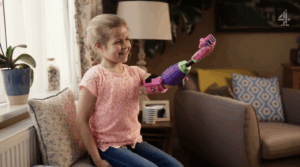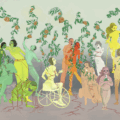
“‘Gee, I’m afraid to go on’ has turned into, ‘Yes, I can’” are some of the opening words to the Sammy Davis Jr. track “Yes I Can” and Channel 4’s 2016 “We’re the Superhumans” Paralympics advertisement.
“We’re the Superhumans” was made as a sequel to Channel 4’s award-winning, critically acclaimed 2012 Paralympics advert, “Meet the Superhumans,” with the goal of widening the lens. Their 2012 ad focused on disabled athletes competing more specifically, while the 2016 ad expanded and also showed disabled people playing instruments, dancing, and doing everyday tasks. “We’re the Superhumans” received similar praise to its predecessor; however, criticism began to surround the possible ableist rhetoric underlying the message of the advertisement.
It is important to note that the point of this article isn’t to speculate about the intent of these adverts or the people who made them, but rather to look at the way ableism shapes how disabled people are viewed and valued by society. It is very possible—and highly likely considering they employed over 140 disabled people and released this ad with accessibility features for the deaf and visually impaired—that the people who put these ads together did so with the intent of creating good disability representation but were blind to the implicit bias impressed upon them by our ableist society.
Neither advertisement is necessarily free of ableism, but where “Meet the Superhumans” toes the line of stereotypes and harmful rhetoric, “We’re the Superhumans” falls right into the trap. To begin to understand this “trap,” there are two important terms we need to define: “inspiration porn” and “supercrip.”
“Inspiration porn” is a term coined by disability rights advocate Stella Young to describe media in which images or videos of people with disabilities doing completely ordinary things are used as a tool to inspire non-disabled people. The issue is that these disabled people aren’t doing anything noteworthy. The thing that’s supposed to be inspirational is how these people you presume are incompetent are capable of doing simple tasks. Ableism is the reason visibly disabled people are assumed to be inferior at first glance, and this use of disabled people turns them into objects of inspiration and removes their personhood.
“Supercrip” is considered a subtype of inspiration porn by many disability activists, while others consider it to be its own stereotype. This refers to when a disabled person is portrayed as having “overcome” their disability through perseverance and mindset. This is seen as heroic and “superhuman,” hence the name, because these disabled people are perceived as becoming more “normal.” While the idea of being heroic may seem like a good thing, a stereotype is still a stereotype. This one in particular emphasizes placing value in how normal a person can be and removes the need for accommodation to make non-disabled people more comfortable.
Channel 4’s “Meet the Superhumans” advert from 2012 can be seen as presenting these Paralympic athletes through the stereotype of the supercrip, but there are a few things that it does right that are just enough to make it seem much less insidious than its 2016 counterpart.
First, by only featuring athletes, “Meet the Superhumans” isn’t creating “inspiration porn” because the things these athletes are doing are impressive, not ordinary. Though, this is where the supercrip comes in. Are they presenting it as impressive because these athletes are highly skilled in their field or because they can do sports non-disabled people play “in spite of” their disability? This also ties into the use of the word “superhuman” in the title and how it plays into the supercrip stereotype.
Bringing it back to what “Meet the Superhumans” did right, they made the ad in very similar ways to how an ad for non-disabled athletes would be made, with a montage of them training and competing set to Public Enemy’s song “Harder Than You Think.” This song choice is not only similar to what you might hear in any other sports ad, but it also has the underlying message of telling people not to passively accept discrimination.
Channel 4 also added a small section around halfway through that emphasized a very important factor of the disability community: anyone can join at any time of their life. People can be born with a disability, but they can also be acquired by anyone, regardless of age, race, gender, socioeconomic status, or any other factor—disability doesn’t discriminate. “Meet the Superhumans” emphasized this by showing clips of ways disabilities are acquired, like in war or car crashes, while also showing things like sonograms to show that a person can be born with their disability.
The 2016 “We’re the Superhumans” made a few small changes that may seem innocent and inclusive but were actually what allowed ableism to slip in and corrupt their messaging.
To start, “We’re the Superhumans” has all the same markings of the supercrip stereotype while also adding in a good amount of inspiration porn as well. Once again they’re using the word “superhuman,” which presents these disabled athletes as heroes for “overcoming” their disabilities. The inspiration porn comes in when Channel 4 decides to juxtapose clips of disabled athletes doing their sports with disabled people doing regular, everyday things, like brushing their teeth or working a job, all with the same uplifting song in the background as if to say disabled people doing any kind of mundane task is just as much of an inspirational feat as competing at a highly competitive level in adaptive sports.
Perhaps the most damning change that was made in the 2016 advertisement, though, was the change of music. Where the 2012 advert’s music was politically charged hip-hop that set a gritty tone, “We’re the Superhumans” uses upbeat swing music to set an uplifting tone with a message emphasizing determination. While this may seem innocent on the surface, even a good choice to encourage perseverance, an ableist outlook on disability lurks just under the surface.
The use of Sammy Davis Jr.’s song “Yes I can,” which gets its name from the main refrain, in this context perpetuates the idea that with enough positive thinking, disability can be “overcome.” The idea of mindset being important isn’t the issue here; it’s the way it places all the responsibility on the individual. It ignores the social and political aspects of disability in favor of telling everyone that if disabled people try harder and smile enough, they can come close to being “normal.”
Channel 4 likely intended for “We’re the Superhumans” to be inclusive and to celebrate disability, but the framing was, unfortunately, laced with ableist influence. When disability is shown as inspiration, representation gives way to stereotype and spectacle. The kind of “representation” in the 2016 advert invites non-disabled people to value the worth of a disabled person in how closely they can approximate “normal” while letting the real, societal barriers fade into the background. Disabled people don’t need to be “superhuman” to be human, and they shouldn’t have to prove their worth to deserve respect.







